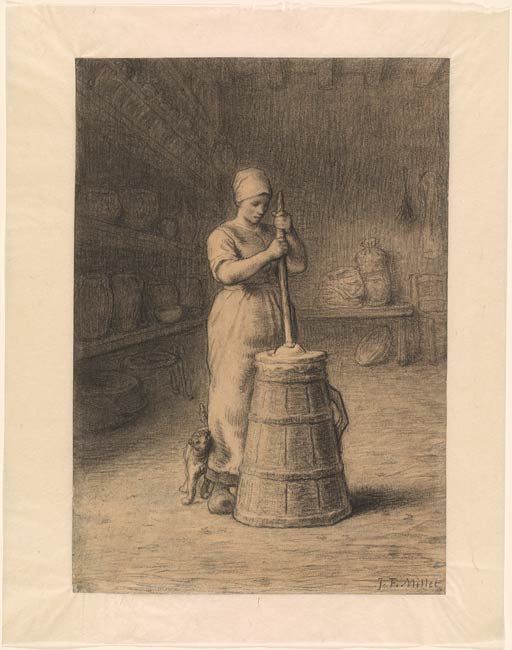

Millet's choice of subject matter-the everyday activities of the rural peasant class around Barbizon- challenged the traditional hierarchy of genres established at the Salon and inspired heated political discussion. In the wake of the 1848 revolution, the agricultural economy of the French countryside underwent a crisis as commercial farms were established and many displaced workers fled small towns to find menial jobs in the cities. The continued tradition of agricultural labor in the towns to find menial jobs in the cities. The continued tradition of agricultural labor in the towns outside Paris formed the subject matter for much of Millet's mature work, and the artist often used a single figure at work as a symbol of la condition humaine.
The artist's representation of genre subjects began on a modest scale while he worked as a portraitist in Le Havre, producing his earliest mature genre paintings about 1847, shortly before he and his family relocated to Barbizon. About 1850 he began to make independent, finished drawings, probably for sale or reproduction and publication. Millet first depicted a woman churning butter in a painting of the mid-1840s (formerly Musée des Beaux-Arts, Montréal) and continued to do so in drawings, etchings, pastels, and paintings, until his last large canvas of 1870 (Malden Public Library, Massachusetts), which was one of two paintings the artist sent to the Salon of 1870 (the other being Novembre, destroyed in Berlin, 1945), the last in which he participated. Alexandra Murphy attributes Millet's fondness for the subject to the crucial role of the production of butter in his native Normandy, which is one of the principal provincial exporters of beurres de luxe to Paris. Encouraged by Alfred Sensier to produce etchings for commercial publication, Millet replicated his compositions, including an earlier one of a woman churning butter, in a number of etchings from the 1850s to 1860s. Murphy noted that this sheet was likely executed shortly after the artist's 1855/56 etching of the subject to a more refined and monumental format.
In his highly finished sheet, a woman, her form slightly molded by light and shadow, stands in a dairy barn lined with shelves. A cat rubs against her legs as she manipulates a butter churn. She wears a marmotte, or a headscarf, commonly worn by Barbizon peasants.
Millet paid great attention to capturing the physical aspects of labor, the stresses and movements of a particular task; his formal vocabulary viscerally evokes the exertion and repetition of routine chores. In the present drawing, the repeated rounded lines and curvilinear forms suggest the repetitive motion of churning.
The verso of this sheet contains a rapidly executed study in Conté crayon representing a shepherd seated on a hillside and leaning on his staff as a small herd of goats grazes and rests. Millet began making drawings of shepherds and their flocks in and around Fontainebleau shortly after arriving at the Barbizon with his family in 1849. The rapid, fluid strokes of Conté crayon in this drawing suggests that the sheet dates to the mid-1850's, when Millet's sketches became more broadly executed and less composed than his earlier work.
By 1907 this drawing had entered the collection of Quincy Adams Shaw (1825-1908), a Boston collector who began buying works by Millet during the early 1870s. Shaw amassed the largest collection of paintings, pastels, and etchings by the artist in America. In 1917 the majority of the collection was given by his heirs to the Museum of Fine Arts, Boston. Woman Churning Butter subsequently was purchased by the sculptor Henry Moore for his extensive private collection of drawings.
Signed in Conté crayon at lower right, "J.F. Millet".
Shaw, Quincy Adams, former owner.
Moore, Henry, former owner.
Moore, Mary, former owner.
Thaw, Eugene Victor, former owner.
Thaw, Clare, former owner.
The Morgan Library & Museum, New York, NY, "Drawn to Greatness: Master Drawings from the Thaw Collection", 2017. Exh. cat., no. 264, repr.
The Thaw Collection : Master Drawings and Oil Sketches : Acquisitions since 1994. New York : Pierpont Morgan Library, 2002, no. 39.
